Contemporary Economics Analysis Report: Unilever Case Study
VerifiedAdded on 2023/06/07
|11
|3020
|65
Report
AI Summary
This report provides a comprehensive analysis of contemporary economics, focusing on microeconomic principles and their practical applications within the retail sector, specifically using Unilever as a case study. The report begins by explaining the law of demand and supply, including movements along the curves and factors influencing them, supported by diagrams. It delves into the concepts of demand and supply, illustrating their relationship with price and quantity demanded or supplied. The report further distinguishes between various economic theories from the 20th and 21st centuries, exploring their relevance in modern economics. It examines the evolution of economic thought, from classical theories to Keynesian economics and beyond, highlighting their impact on contemporary business practices. The report considers factors such as consumer preferences, income levels, advertising expenditure, prices of related goods, and the number of consumers in the market. The supply side considers number of sellers, prices, taxes and subsidies and technology. The conclusion synthesizes the key findings and emphasizes the importance of understanding these economic principles for effective business decision-making in a dynamic global market. The report includes diagrams to illustrate key concepts and references relevant academic literature. The report also includes a discussion on the evolution of economic thought and its relevance to contemporary business practices.
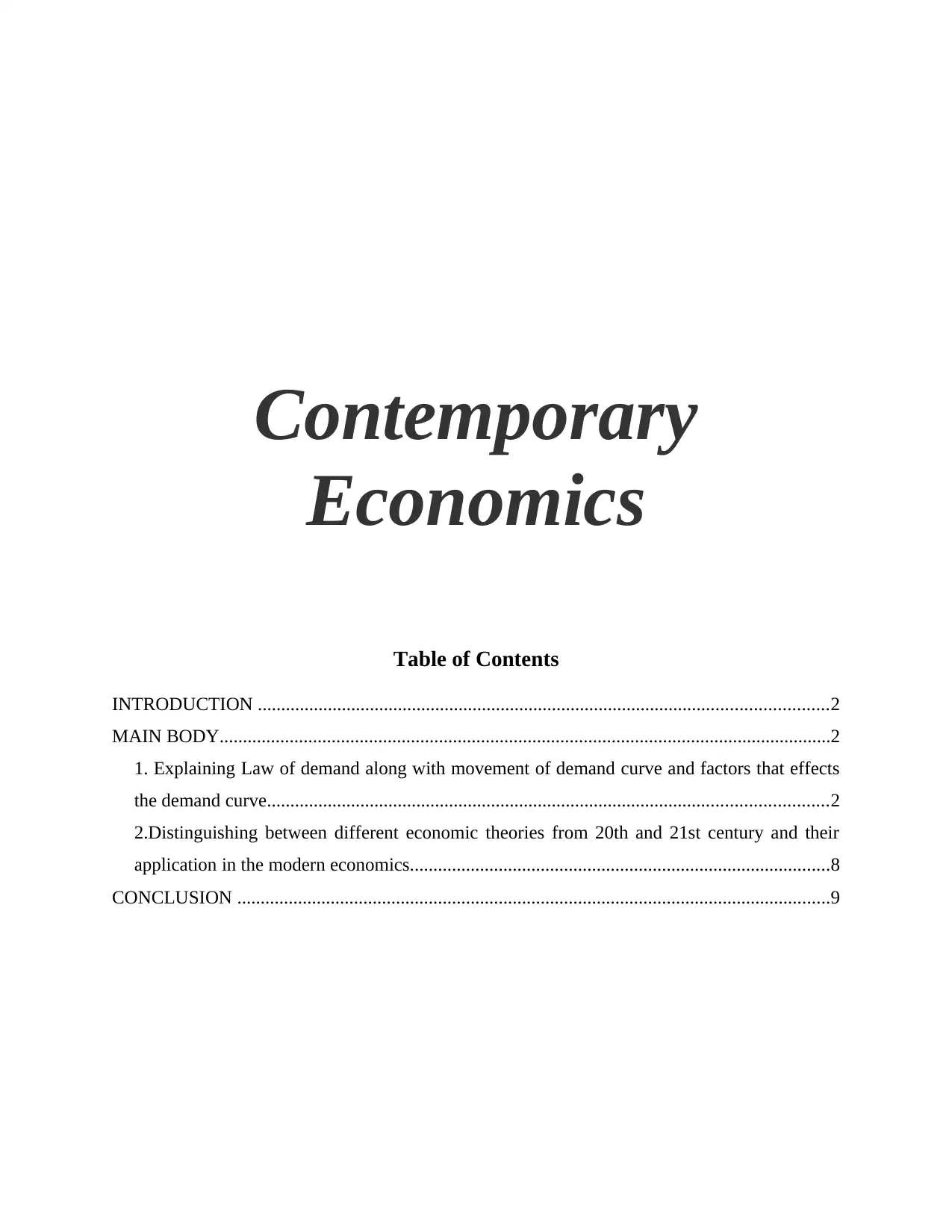
Contemporary
Economics
Table of Contents
INTRODUCTION ..........................................................................................................................2
MAIN BODY...................................................................................................................................2
1. Explaining Law of demand along with movement of demand curve and factors that effects
the demand curve........................................................................................................................2
2.Distinguishing between different economic theories from 20th and 21st century and their
application in the modern economics..........................................................................................8
CONCLUSION ...............................................................................................................................9
Economics
Table of Contents
INTRODUCTION ..........................................................................................................................2
MAIN BODY...................................................................................................................................2
1. Explaining Law of demand along with movement of demand curve and factors that effects
the demand curve........................................................................................................................2
2.Distinguishing between different economic theories from 20th and 21st century and their
application in the modern economics..........................................................................................8
CONCLUSION ...............................................................................................................................9
Paraphrase This Document
Need a fresh take? Get an instant paraphrase of this document with our AI Paraphraser
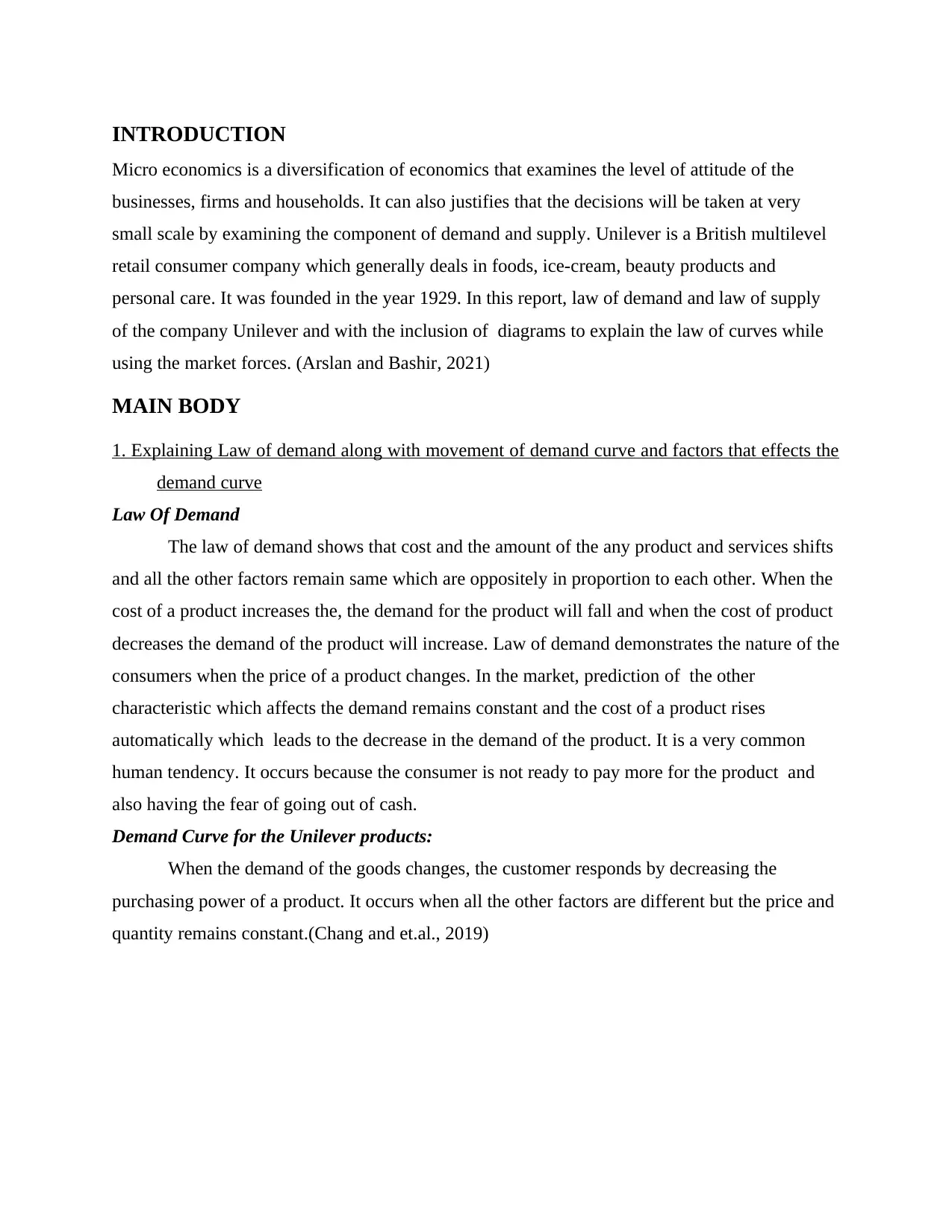
INTRODUCTION
Micro economics is a diversification of economics that examines the level of attitude of the
businesses, firms and households. It can also justifies that the decisions will be taken at very
small scale by examining the component of demand and supply. Unilever is a British multilevel
retail consumer company which generally deals in foods, ice-cream, beauty products and
personal care. It was founded in the year 1929. In this report, law of demand and law of supply
of the company Unilever and with the inclusion of diagrams to explain the law of curves while
using the market forces. (Arslan and Bashir, 2021)
MAIN BODY
1. Explaining Law of demand along with movement of demand curve and factors that effects the
demand curve
Law Of Demand
The law of demand shows that cost and the amount of the any product and services shifts
and all the other factors remain same which are oppositely in proportion to each other. When the
cost of a product increases the, the demand for the product will fall and when the cost of product
decreases the demand of the product will increase. Law of demand demonstrates the nature of the
consumers when the price of a product changes. In the market, prediction of the other
characteristic which affects the demand remains constant and the cost of a product rises
automatically which leads to the decrease in the demand of the product. It is a very common
human tendency. It occurs because the consumer is not ready to pay more for the product and
also having the fear of going out of cash.
Demand Curve for the Unilever products:
When the demand of the goods changes, the customer responds by decreasing the
purchasing power of a product. It occurs when all the other factors are different but the price and
quantity remains constant.(Chang and et.al., 2019)
Micro economics is a diversification of economics that examines the level of attitude of the
businesses, firms and households. It can also justifies that the decisions will be taken at very
small scale by examining the component of demand and supply. Unilever is a British multilevel
retail consumer company which generally deals in foods, ice-cream, beauty products and
personal care. It was founded in the year 1929. In this report, law of demand and law of supply
of the company Unilever and with the inclusion of diagrams to explain the law of curves while
using the market forces. (Arslan and Bashir, 2021)
MAIN BODY
1. Explaining Law of demand along with movement of demand curve and factors that effects the
demand curve
Law Of Demand
The law of demand shows that cost and the amount of the any product and services shifts
and all the other factors remain same which are oppositely in proportion to each other. When the
cost of a product increases the, the demand for the product will fall and when the cost of product
decreases the demand of the product will increase. Law of demand demonstrates the nature of the
consumers when the price of a product changes. In the market, prediction of the other
characteristic which affects the demand remains constant and the cost of a product rises
automatically which leads to the decrease in the demand of the product. It is a very common
human tendency. It occurs because the consumer is not ready to pay more for the product and
also having the fear of going out of cash.
Demand Curve for the Unilever products:
When the demand of the goods changes, the customer responds by decreasing the
purchasing power of a product. It occurs when all the other factors are different but the price and
quantity remains constant.(Chang and et.al., 2019)
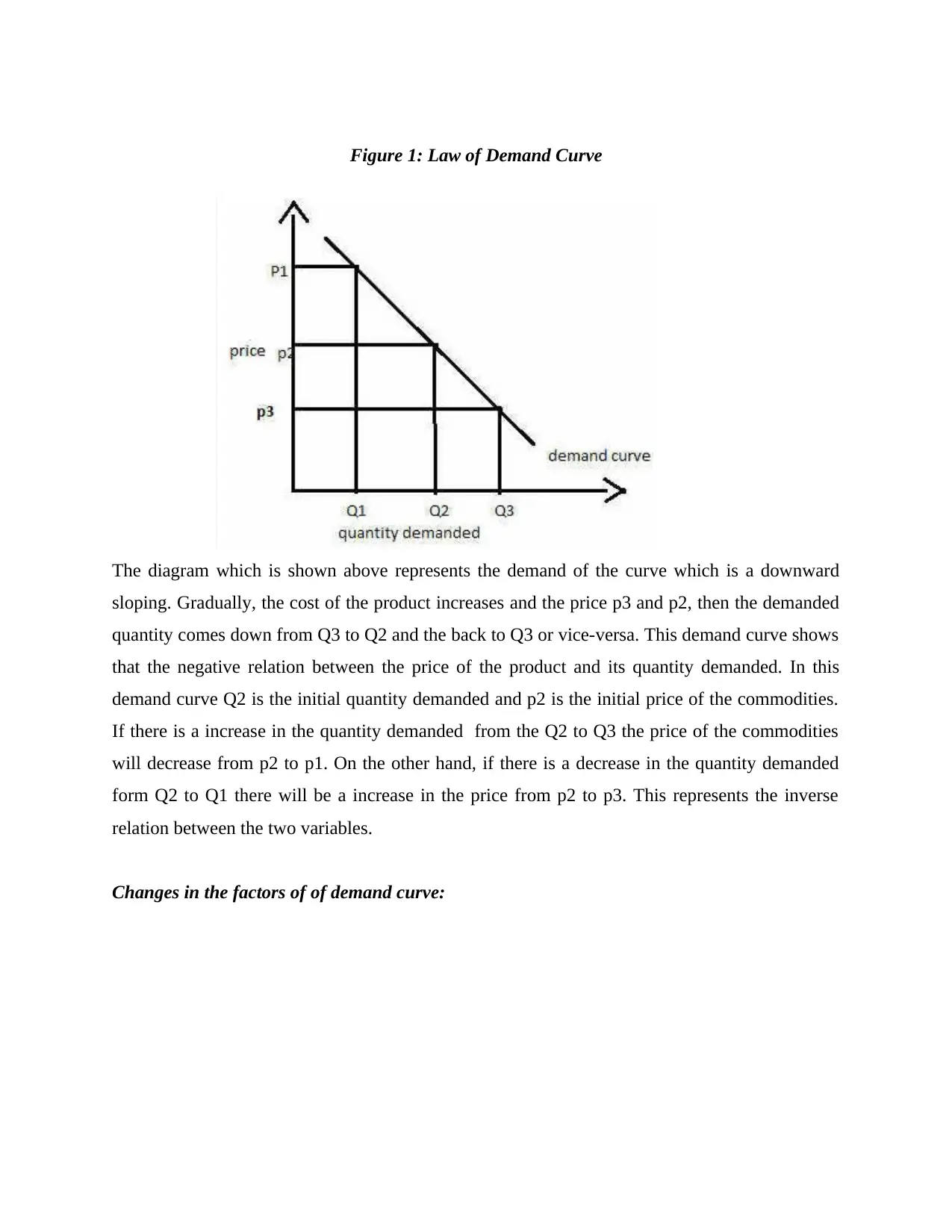
Figure 1: Law of Demand Curve
The diagram which is shown above represents the demand of the curve which is a downward
sloping. Gradually, the cost of the product increases and the price p3 and p2, then the demanded
quantity comes down from Q3 to Q2 and the back to Q3 or vice-versa. This demand curve shows
that the negative relation between the price of the product and its quantity demanded. In this
demand curve Q2 is the initial quantity demanded and p2 is the initial price of the commodities.
If there is a increase in the quantity demanded from the Q2 to Q3 the price of the commodities
will decrease from p2 to p1. On the other hand, if there is a decrease in the quantity demanded
form Q2 to Q1 there will be a increase in the price from p2 to p3. This represents the inverse
relation between the two variables.
Changes in the factors of of demand curve:
The diagram which is shown above represents the demand of the curve which is a downward
sloping. Gradually, the cost of the product increases and the price p3 and p2, then the demanded
quantity comes down from Q3 to Q2 and the back to Q3 or vice-versa. This demand curve shows
that the negative relation between the price of the product and its quantity demanded. In this
demand curve Q2 is the initial quantity demanded and p2 is the initial price of the commodities.
If there is a increase in the quantity demanded from the Q2 to Q3 the price of the commodities
will decrease from p2 to p1. On the other hand, if there is a decrease in the quantity demanded
form Q2 to Q1 there will be a increase in the price from p2 to p3. This represents the inverse
relation between the two variables.
Changes in the factors of of demand curve:
⊘ This is a preview!⊘
Do you want full access?
Subscribe today to unlock all pages.

Trusted by 1+ million students worldwide
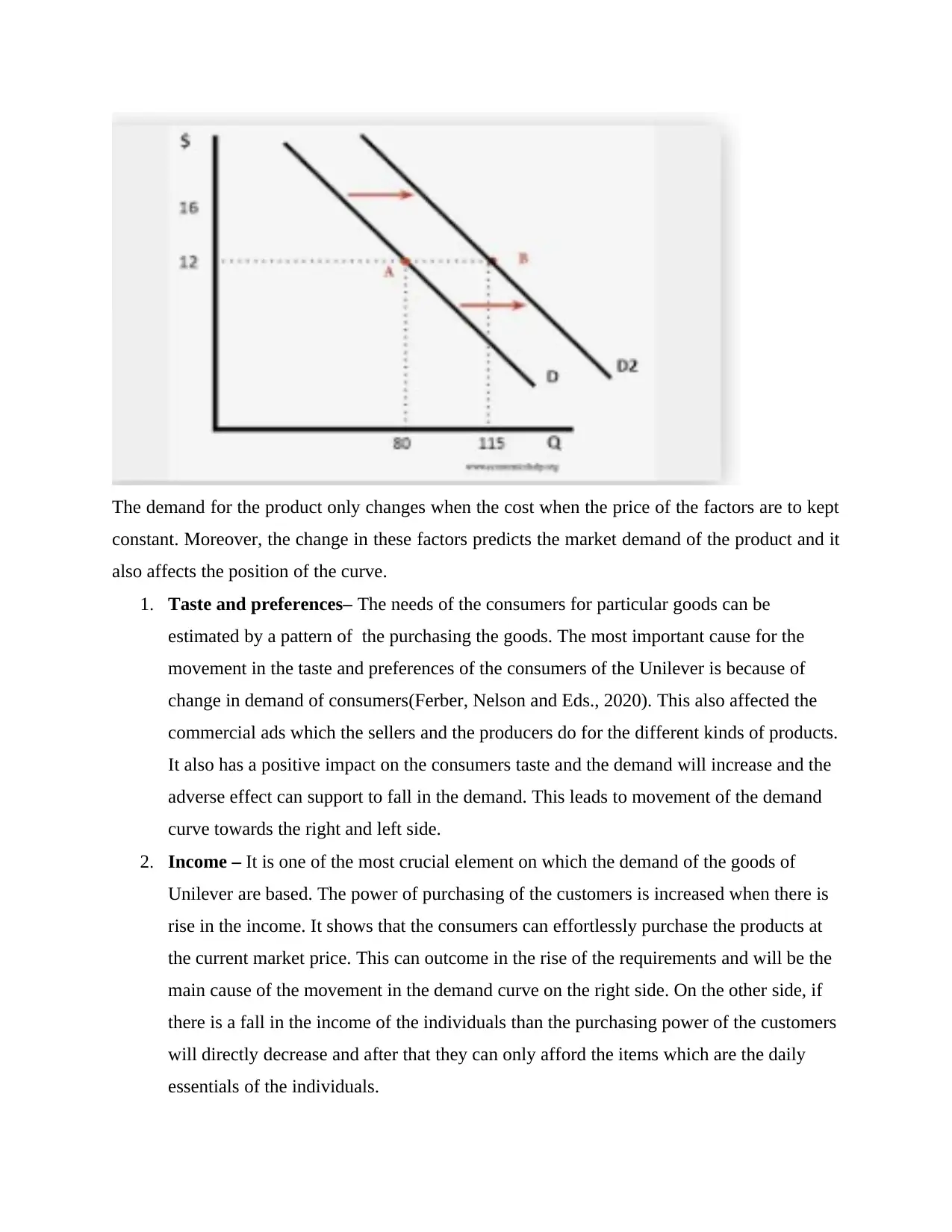
The demand for the product only changes when the cost when the price of the factors are to kept
constant. Moreover, the change in these factors predicts the market demand of the product and it
also affects the position of the curve.
1. Taste and preferences– The needs of the consumers for particular goods can be
estimated by a pattern of the purchasing the goods. The most important cause for the
movement in the taste and preferences of the consumers of the Unilever is because of
change in demand of consumers(Ferber, Nelson and Eds., 2020). This also affected the
commercial ads which the sellers and the producers do for the different kinds of products.
It also has a positive impact on the consumers taste and the demand will increase and the
adverse effect can support to fall in the demand. This leads to movement of the demand
curve towards the right and left side.
2. Income – It is one of the most crucial element on which the demand of the goods of
Unilever are based. The power of purchasing of the customers is increased when there is
rise in the income. It shows that the consumers can effortlessly purchase the products at
the current market price. This can outcome in the rise of the requirements and will be the
main cause of the movement in the demand curve on the right side. On the other side, if
there is a fall in the income of the individuals than the purchasing power of the customers
will directly decrease and after that they can only afford the items which are the daily
essentials of the individuals.
constant. Moreover, the change in these factors predicts the market demand of the product and it
also affects the position of the curve.
1. Taste and preferences– The needs of the consumers for particular goods can be
estimated by a pattern of the purchasing the goods. The most important cause for the
movement in the taste and preferences of the consumers of the Unilever is because of
change in demand of consumers(Ferber, Nelson and Eds., 2020). This also affected the
commercial ads which the sellers and the producers do for the different kinds of products.
It also has a positive impact on the consumers taste and the demand will increase and the
adverse effect can support to fall in the demand. This leads to movement of the demand
curve towards the right and left side.
2. Income – It is one of the most crucial element on which the demand of the goods of
Unilever are based. The power of purchasing of the customers is increased when there is
rise in the income. It shows that the consumers can effortlessly purchase the products at
the current market price. This can outcome in the rise of the requirements and will be the
main cause of the movement in the demand curve on the right side. On the other side, if
there is a fall in the income of the individuals than the purchasing power of the customers
will directly decrease and after that they can only afford the items which are the daily
essentials of the individuals.
Paraphrase This Document
Need a fresh take? Get an instant paraphrase of this document with our AI Paraphraser
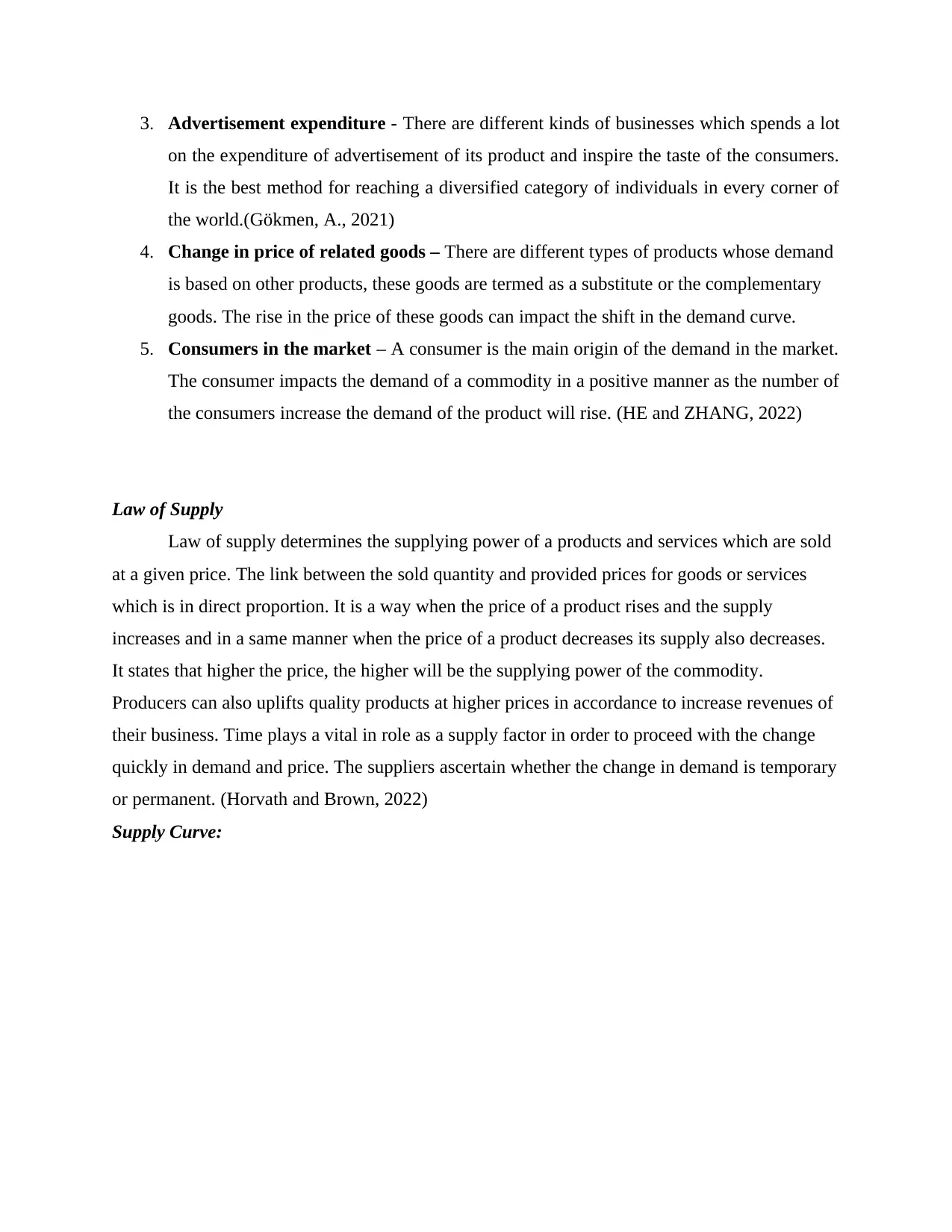
3. Advertisement expenditure - There are different kinds of businesses which spends a lot
on the expenditure of advertisement of its product and inspire the taste of the consumers.
It is the best method for reaching a diversified category of individuals in every corner of
the world.(Gökmen, A., 2021)
4. Change in price of related goods – There are different types of products whose demand
is based on other products, these goods are termed as a substitute or the complementary
goods. The rise in the price of these goods can impact the shift in the demand curve.
5. Consumers in the market – A consumer is the main origin of the demand in the market.
The consumer impacts the demand of a commodity in a positive manner as the number of
the consumers increase the demand of the product will rise. (HE and ZHANG, 2022)
Law of Supply
Law of supply determines the supplying power of a products and services which are sold
at a given price. The link between the sold quantity and provided prices for goods or services
which is in direct proportion. It is a way when the price of a product rises and the supply
increases and in a same manner when the price of a product decreases its supply also decreases.
It states that higher the price, the higher will be the supplying power of the commodity.
Producers can also uplifts quality products at higher prices in accordance to increase revenues of
their business. Time plays a vital in role as a supply factor in order to proceed with the change
quickly in demand and price. The suppliers ascertain whether the change in demand is temporary
or permanent. (Horvath and Brown, 2022)
Supply Curve:
on the expenditure of advertisement of its product and inspire the taste of the consumers.
It is the best method for reaching a diversified category of individuals in every corner of
the world.(Gökmen, A., 2021)
4. Change in price of related goods – There are different types of products whose demand
is based on other products, these goods are termed as a substitute or the complementary
goods. The rise in the price of these goods can impact the shift in the demand curve.
5. Consumers in the market – A consumer is the main origin of the demand in the market.
The consumer impacts the demand of a commodity in a positive manner as the number of
the consumers increase the demand of the product will rise. (HE and ZHANG, 2022)
Law of Supply
Law of supply determines the supplying power of a products and services which are sold
at a given price. The link between the sold quantity and provided prices for goods or services
which is in direct proportion. It is a way when the price of a product rises and the supply
increases and in a same manner when the price of a product decreases its supply also decreases.
It states that higher the price, the higher will be the supplying power of the commodity.
Producers can also uplifts quality products at higher prices in accordance to increase revenues of
their business. Time plays a vital in role as a supply factor in order to proceed with the change
quickly in demand and price. The suppliers ascertain whether the change in demand is temporary
or permanent. (Horvath and Brown, 2022)
Supply Curve:
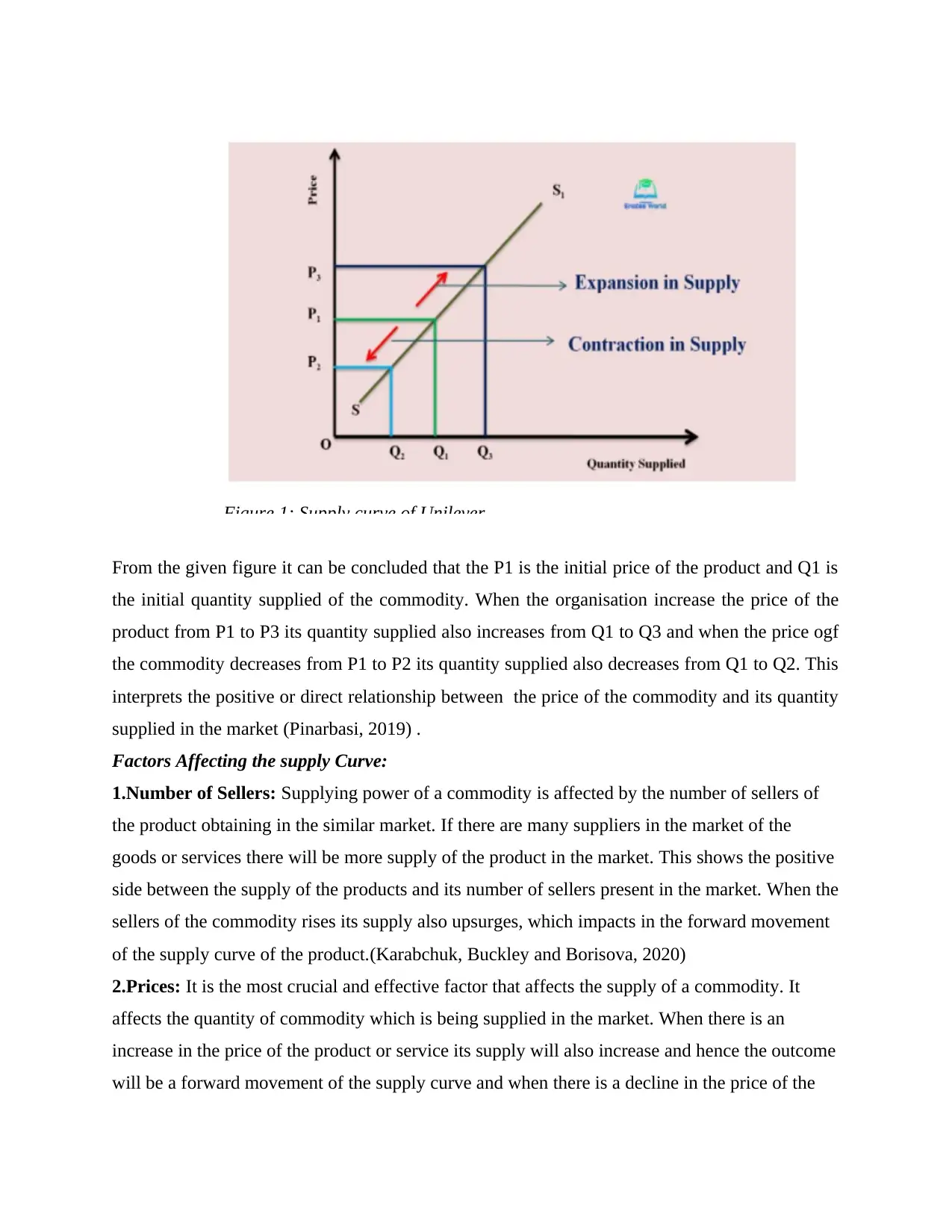
From the given figure it can be concluded that the P1 is the initial price of the product and Q1 is
the initial quantity supplied of the commodity. When the organisation increase the price of the
product from P1 to P3 its quantity supplied also increases from Q1 to Q3 and when the price ogf
the commodity decreases from P1 to P2 its quantity supplied also decreases from Q1 to Q2. This
interprets the positive or direct relationship between the price of the commodity and its quantity
supplied in the market (Pinarbasi, 2019) .
Factors Affecting the supply Curve:
1.Number of Sellers: Supplying power of a commodity is affected by the number of sellers of
the product obtaining in the similar market. If there are many suppliers in the market of the
goods or services there will be more supply of the product in the market. This shows the positive
side between the supply of the products and its number of sellers present in the market. When the
sellers of the commodity rises its supply also upsurges, which impacts in the forward movement
of the supply curve of the product.(Karabchuk, Buckley and Borisova, 2020)
2.Prices: It is the most crucial and effective factor that affects the supply of a commodity. It
affects the quantity of commodity which is being supplied in the market. When there is an
increase in the price of the product or service its supply will also increase and hence the outcome
will be a forward movement of the supply curve and when there is a decline in the price of the
Figure 1: Supply curve of Unilever
the initial quantity supplied of the commodity. When the organisation increase the price of the
product from P1 to P3 its quantity supplied also increases from Q1 to Q3 and when the price ogf
the commodity decreases from P1 to P2 its quantity supplied also decreases from Q1 to Q2. This
interprets the positive or direct relationship between the price of the commodity and its quantity
supplied in the market (Pinarbasi, 2019) .
Factors Affecting the supply Curve:
1.Number of Sellers: Supplying power of a commodity is affected by the number of sellers of
the product obtaining in the similar market. If there are many suppliers in the market of the
goods or services there will be more supply of the product in the market. This shows the positive
side between the supply of the products and its number of sellers present in the market. When the
sellers of the commodity rises its supply also upsurges, which impacts in the forward movement
of the supply curve of the product.(Karabchuk, Buckley and Borisova, 2020)
2.Prices: It is the most crucial and effective factor that affects the supply of a commodity. It
affects the quantity of commodity which is being supplied in the market. When there is an
increase in the price of the product or service its supply will also increase and hence the outcome
will be a forward movement of the supply curve and when there is a decline in the price of the
Figure 1: Supply curve of Unilever
⊘ This is a preview!⊘
Do you want full access?
Subscribe today to unlock all pages.

Trusted by 1+ million students worldwide
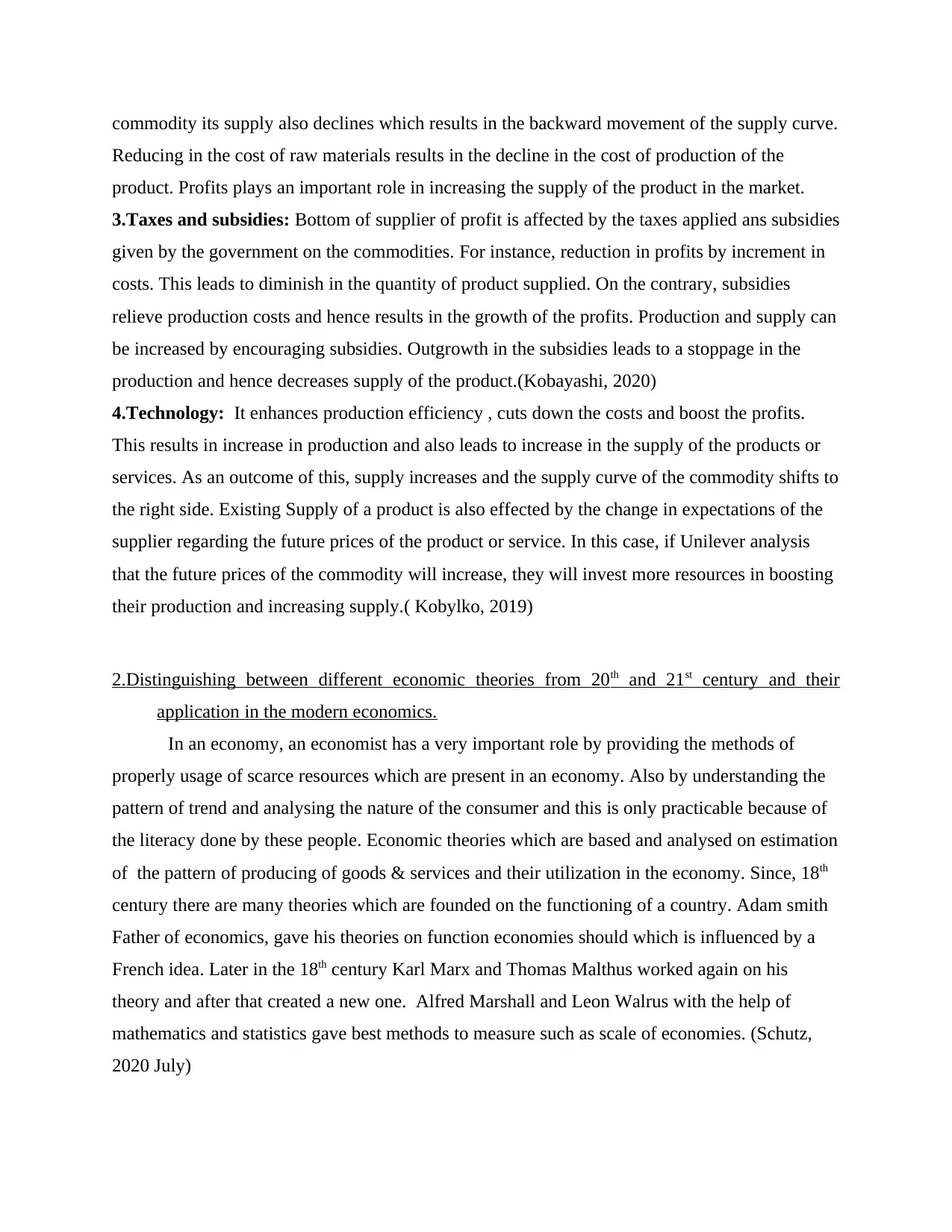
commodity its supply also declines which results in the backward movement of the supply curve.
Reducing in the cost of raw materials results in the decline in the cost of production of the
product. Profits plays an important role in increasing the supply of the product in the market.
3.Taxes and subsidies: Bottom of supplier of profit is affected by the taxes applied ans subsidies
given by the government on the commodities. For instance, reduction in profits by increment in
costs. This leads to diminish in the quantity of product supplied. On the contrary, subsidies
relieve production costs and hence results in the growth of the profits. Production and supply can
be increased by encouraging subsidies. Outgrowth in the subsidies leads to a stoppage in the
production and hence decreases supply of the product.(Kobayashi, 2020)
4.Technology: It enhances production efficiency , cuts down the costs and boost the profits.
This results in increase in production and also leads to increase in the supply of the products or
services. As an outcome of this, supply increases and the supply curve of the commodity shifts to
the right side. Existing Supply of a product is also effected by the change in expectations of the
supplier regarding the future prices of the product or service. In this case, if Unilever analysis
that the future prices of the commodity will increase, they will invest more resources in boosting
their production and increasing supply.( Kobylko, 2019)
2.Distinguishing between different economic theories from 20th and 21st century and their
application in the modern economics.
In an economy, an economist has a very important role by providing the methods of
properly usage of scarce resources which are present in an economy. Also by understanding the
pattern of trend and analysing the nature of the consumer and this is only practicable because of
the literacy done by these people. Economic theories which are based and analysed on estimation
of the pattern of producing of goods & services and their utilization in the economy. Since, 18th
century there are many theories which are founded on the functioning of a country. Adam smith
Father of economics, gave his theories on function economies should which is influenced by a
French idea. Later in the 18th century Karl Marx and Thomas Malthus worked again on his
theory and after that created a new one. Alfred Marshall and Leon Walrus with the help of
mathematics and statistics gave best methods to measure such as scale of economies. (Schutz,
2020 July)
Reducing in the cost of raw materials results in the decline in the cost of production of the
product. Profits plays an important role in increasing the supply of the product in the market.
3.Taxes and subsidies: Bottom of supplier of profit is affected by the taxes applied ans subsidies
given by the government on the commodities. For instance, reduction in profits by increment in
costs. This leads to diminish in the quantity of product supplied. On the contrary, subsidies
relieve production costs and hence results in the growth of the profits. Production and supply can
be increased by encouraging subsidies. Outgrowth in the subsidies leads to a stoppage in the
production and hence decreases supply of the product.(Kobayashi, 2020)
4.Technology: It enhances production efficiency , cuts down the costs and boost the profits.
This results in increase in production and also leads to increase in the supply of the products or
services. As an outcome of this, supply increases and the supply curve of the commodity shifts to
the right side. Existing Supply of a product is also effected by the change in expectations of the
supplier regarding the future prices of the product or service. In this case, if Unilever analysis
that the future prices of the commodity will increase, they will invest more resources in boosting
their production and increasing supply.( Kobylko, 2019)
2.Distinguishing between different economic theories from 20th and 21st century and their
application in the modern economics.
In an economy, an economist has a very important role by providing the methods of
properly usage of scarce resources which are present in an economy. Also by understanding the
pattern of trend and analysing the nature of the consumer and this is only practicable because of
the literacy done by these people. Economic theories which are based and analysed on estimation
of the pattern of producing of goods & services and their utilization in the economy. Since, 18th
century there are many theories which are founded on the functioning of a country. Adam smith
Father of economics, gave his theories on function economies should which is influenced by a
French idea. Later in the 18th century Karl Marx and Thomas Malthus worked again on his
theory and after that created a new one. Alfred Marshall and Leon Walrus with the help of
mathematics and statistics gave best methods to measure such as scale of economies. (Schutz,
2020 July)
Paraphrase This Document
Need a fresh take? Get an instant paraphrase of this document with our AI Paraphraser
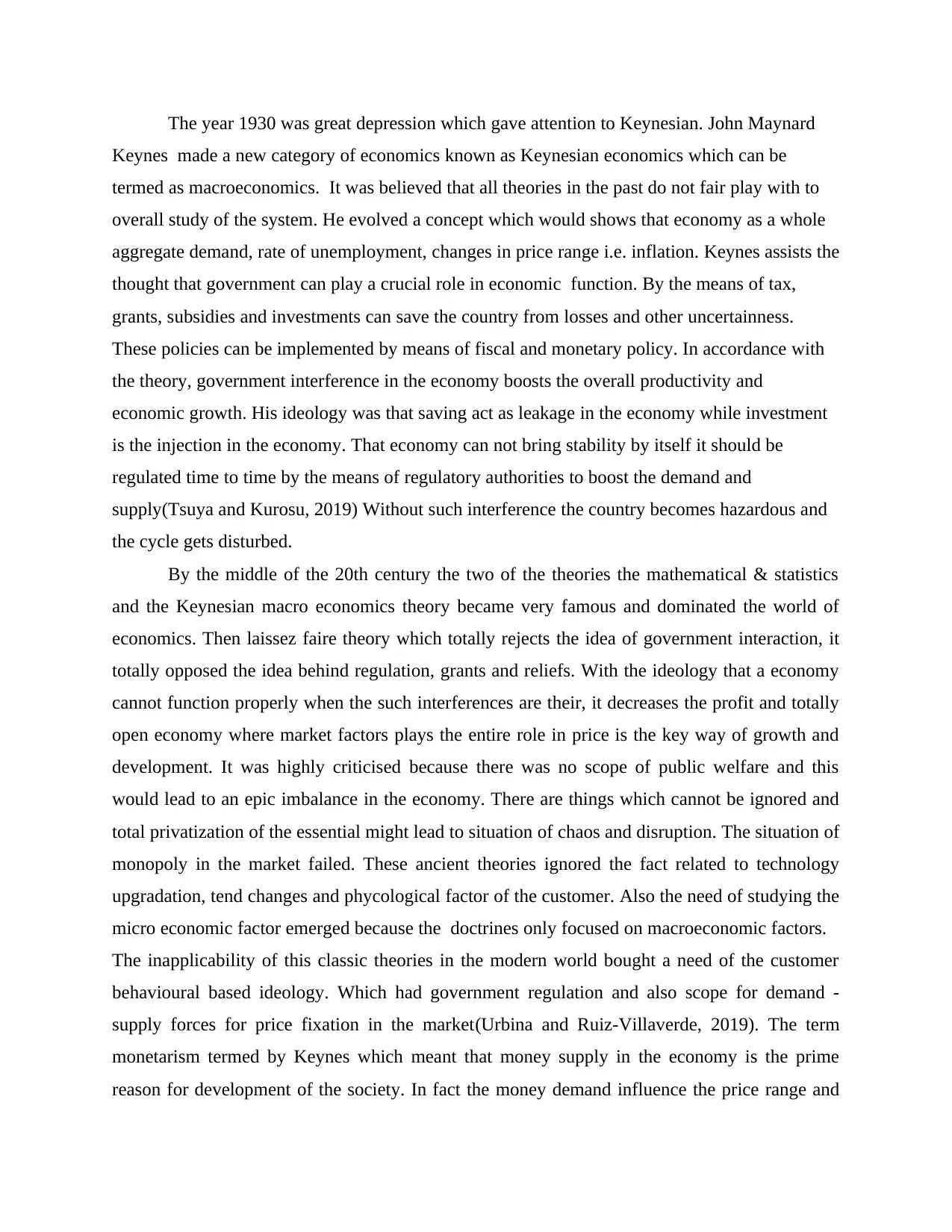
The year 1930 was great depression which gave attention to Keynesian. John Maynard
Keynes made a new category of economics known as Keynesian economics which can be
termed as macroeconomics. It was believed that all theories in the past do not fair play with to
overall study of the system. He evolved a concept which would shows that economy as a whole
aggregate demand, rate of unemployment, changes in price range i.e. inflation. Keynes assists the
thought that government can play a crucial role in economic function. By the means of tax,
grants, subsidies and investments can save the country from losses and other uncertainness.
These policies can be implemented by means of fiscal and monetary policy. In accordance with
the theory, government interference in the economy boosts the overall productivity and
economic growth. His ideology was that saving act as leakage in the economy while investment
is the injection in the economy. That economy can not bring stability by itself it should be
regulated time to time by the means of regulatory authorities to boost the demand and
supply(Tsuya and Kurosu, 2019) Without such interference the country becomes hazardous and
the cycle gets disturbed.
By the middle of the 20th century the two of the theories the mathematical & statistics
and the Keynesian macro economics theory became very famous and dominated the world of
economics. Then laissez faire theory which totally rejects the idea of government interaction, it
totally opposed the idea behind regulation, grants and reliefs. With the ideology that a economy
cannot function properly when the such interferences are their, it decreases the profit and totally
open economy where market factors plays the entire role in price is the key way of growth and
development. It was highly criticised because there was no scope of public welfare and this
would lead to an epic imbalance in the economy. There are things which cannot be ignored and
total privatization of the essential might lead to situation of chaos and disruption. The situation of
monopoly in the market failed. These ancient theories ignored the fact related to technology
upgradation, tend changes and phycological factor of the customer. Also the need of studying the
micro economic factor emerged because the doctrines only focused on macroeconomic factors.
The inapplicability of this classic theories in the modern world bought a need of the customer
behavioural based ideology. Which had government regulation and also scope for demand -
supply forces for price fixation in the market(Urbina and Ruiz‐Villaverde, 2019). The term
monetarism termed by Keynes which meant that money supply in the economy is the prime
reason for development of the society. In fact the money demand influence the price range and
Keynes made a new category of economics known as Keynesian economics which can be
termed as macroeconomics. It was believed that all theories in the past do not fair play with to
overall study of the system. He evolved a concept which would shows that economy as a whole
aggregate demand, rate of unemployment, changes in price range i.e. inflation. Keynes assists the
thought that government can play a crucial role in economic function. By the means of tax,
grants, subsidies and investments can save the country from losses and other uncertainness.
These policies can be implemented by means of fiscal and monetary policy. In accordance with
the theory, government interference in the economy boosts the overall productivity and
economic growth. His ideology was that saving act as leakage in the economy while investment
is the injection in the economy. That economy can not bring stability by itself it should be
regulated time to time by the means of regulatory authorities to boost the demand and
supply(Tsuya and Kurosu, 2019) Without such interference the country becomes hazardous and
the cycle gets disturbed.
By the middle of the 20th century the two of the theories the mathematical & statistics
and the Keynesian macro economics theory became very famous and dominated the world of
economics. Then laissez faire theory which totally rejects the idea of government interaction, it
totally opposed the idea behind regulation, grants and reliefs. With the ideology that a economy
cannot function properly when the such interferences are their, it decreases the profit and totally
open economy where market factors plays the entire role in price is the key way of growth and
development. It was highly criticised because there was no scope of public welfare and this
would lead to an epic imbalance in the economy. There are things which cannot be ignored and
total privatization of the essential might lead to situation of chaos and disruption. The situation of
monopoly in the market failed. These ancient theories ignored the fact related to technology
upgradation, tend changes and phycological factor of the customer. Also the need of studying the
micro economic factor emerged because the doctrines only focused on macroeconomic factors.
The inapplicability of this classic theories in the modern world bought a need of the customer
behavioural based ideology. Which had government regulation and also scope for demand -
supply forces for price fixation in the market(Urbina and Ruiz‐Villaverde, 2019). The term
monetarism termed by Keynes which meant that money supply in the economy is the prime
reason for development of the society. In fact the money demand influence the price range and
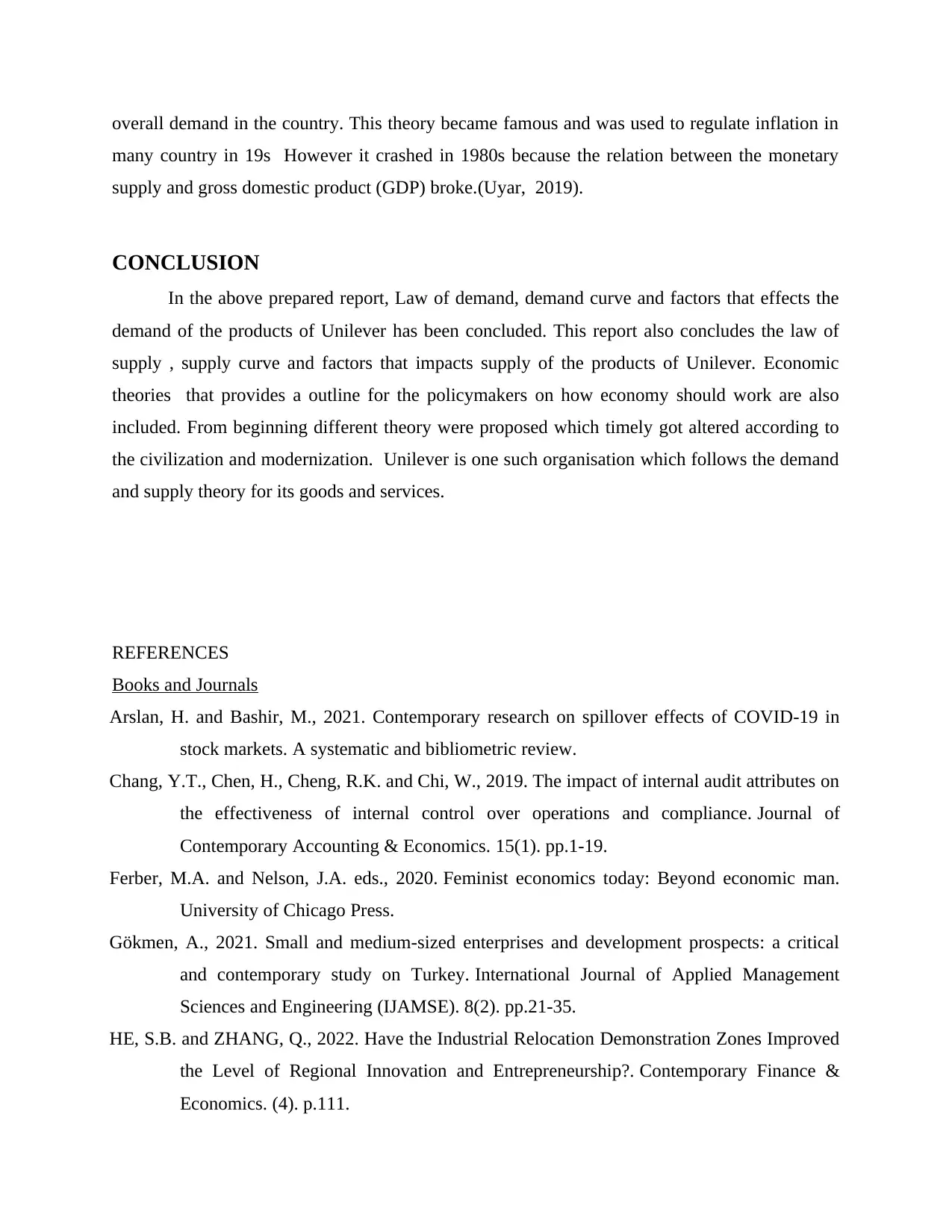
overall demand in the country. This theory became famous and was used to regulate inflation in
many country in 19s However it crashed in 1980s because the relation between the monetary
supply and gross domestic product (GDP) broke.(Uyar, 2019).
CONCLUSION
In the above prepared report, Law of demand, demand curve and factors that effects the
demand of the products of Unilever has been concluded. This report also concludes the law of
supply , supply curve and factors that impacts supply of the products of Unilever. Economic
theories that provides a outline for the policymakers on how economy should work are also
included. From beginning different theory were proposed which timely got altered according to
the civilization and modernization. Unilever is one such organisation which follows the demand
and supply theory for its goods and services.
REFERENCES
Books and Journals
Arslan, H. and Bashir, M., 2021. Contemporary research on spillover effects of COVID-19 in
stock markets. A systematic and bibliometric review.
Chang, Y.T., Chen, H., Cheng, R.K. and Chi, W., 2019. The impact of internal audit attributes on
the effectiveness of internal control over operations and compliance. Journal of
Contemporary Accounting & Economics. 15(1). pp.1-19.
Ferber, M.A. and Nelson, J.A. eds., 2020. Feminist economics today: Beyond economic man.
University of Chicago Press.
Gökmen, A., 2021. Small and medium-sized enterprises and development prospects: a critical
and contemporary study on Turkey. International Journal of Applied Management
Sciences and Engineering (IJAMSE). 8(2). pp.21-35.
HE, S.B. and ZHANG, Q., 2022. Have the Industrial Relocation Demonstration Zones Improved
the Level of Regional Innovation and Entrepreneurship?. Contemporary Finance &
Economics. (4). p.111.
many country in 19s However it crashed in 1980s because the relation between the monetary
supply and gross domestic product (GDP) broke.(Uyar, 2019).
CONCLUSION
In the above prepared report, Law of demand, demand curve and factors that effects the
demand of the products of Unilever has been concluded. This report also concludes the law of
supply , supply curve and factors that impacts supply of the products of Unilever. Economic
theories that provides a outline for the policymakers on how economy should work are also
included. From beginning different theory were proposed which timely got altered according to
the civilization and modernization. Unilever is one such organisation which follows the demand
and supply theory for its goods and services.
REFERENCES
Books and Journals
Arslan, H. and Bashir, M., 2021. Contemporary research on spillover effects of COVID-19 in
stock markets. A systematic and bibliometric review.
Chang, Y.T., Chen, H., Cheng, R.K. and Chi, W., 2019. The impact of internal audit attributes on
the effectiveness of internal control over operations and compliance. Journal of
Contemporary Accounting & Economics. 15(1). pp.1-19.
Ferber, M.A. and Nelson, J.A. eds., 2020. Feminist economics today: Beyond economic man.
University of Chicago Press.
Gökmen, A., 2021. Small and medium-sized enterprises and development prospects: a critical
and contemporary study on Turkey. International Journal of Applied Management
Sciences and Engineering (IJAMSE). 8(2). pp.21-35.
HE, S.B. and ZHANG, Q., 2022. Have the Industrial Relocation Demonstration Zones Improved
the Level of Regional Innovation and Entrepreneurship?. Contemporary Finance &
Economics. (4). p.111.
⊘ This is a preview!⊘
Do you want full access?
Subscribe today to unlock all pages.

Trusted by 1+ million students worldwide
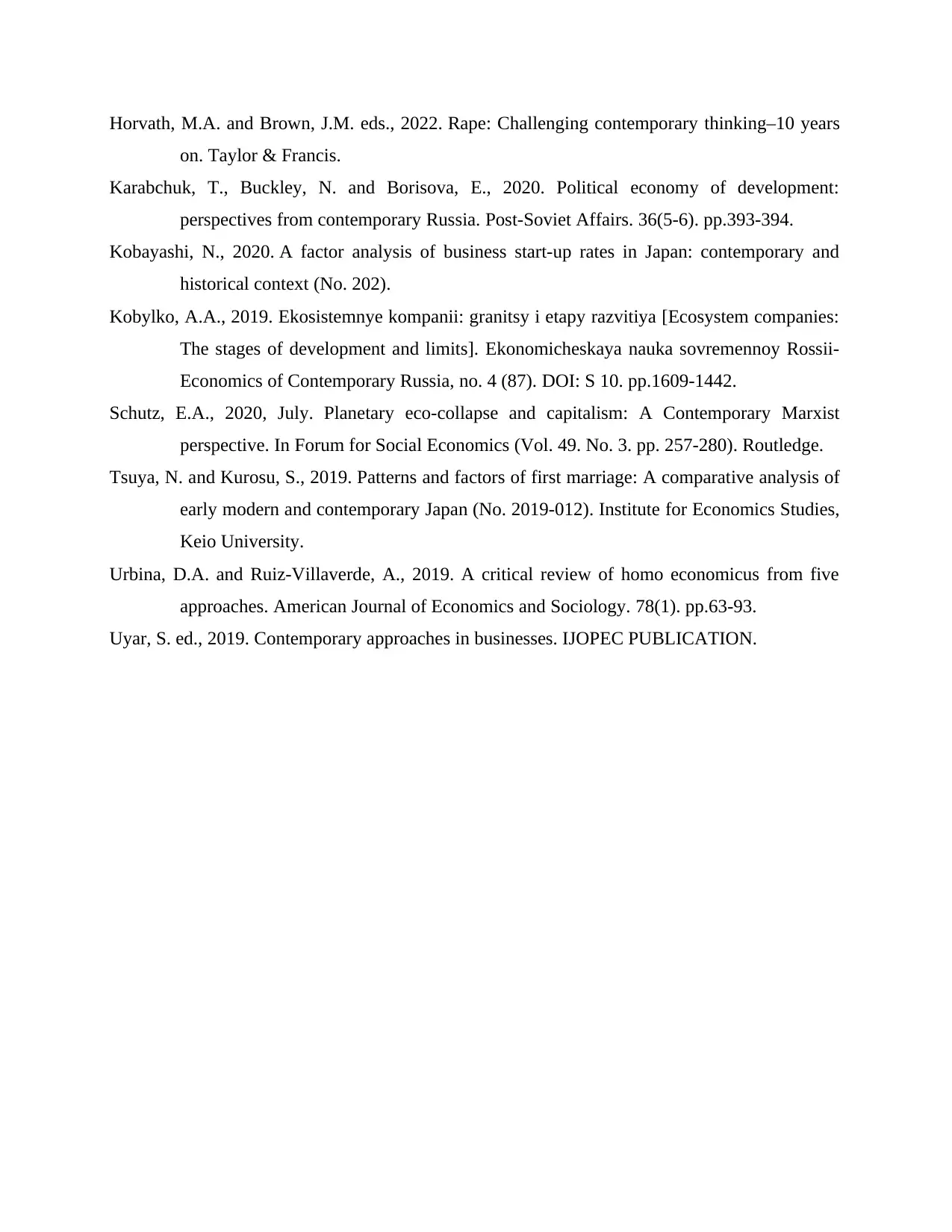
Horvath, M.A. and Brown, J.M. eds., 2022. Rape: Challenging contemporary thinking–10 years
on. Taylor & Francis.
Karabchuk, T., Buckley, N. and Borisova, E., 2020. Political economy of development:
perspectives from contemporary Russia. Post-Soviet Affairs. 36(5-6). pp.393-394.
Kobayashi, N., 2020. A factor analysis of business start-up rates in Japan: contemporary and
historical context (No. 202).
Kobylko, A.A., 2019. Ekosistemnye kompanii: granitsy i etapy razvitiya [Ecosystem companies:
The stages of development and limits]. Ekonomicheskaya nauka sovremennoy Rossii-
Economics of Contemporary Russia, no. 4 (87). DOI: S 10. pp.1609-1442.
Schutz, E.A., 2020, July. Planetary eco-collapse and capitalism: A Contemporary Marxist
perspective. In Forum for Social Economics (Vol. 49. No. 3. pp. 257-280). Routledge.
Tsuya, N. and Kurosu, S., 2019. Patterns and factors of first marriage: A comparative analysis of
early modern and contemporary Japan (No. 2019-012). Institute for Economics Studies,
Keio University.
Urbina, D.A. and Ruiz‐Villaverde, A., 2019. A critical review of homo economicus from five
approaches. American Journal of Economics and Sociology. 78(1). pp.63-93.
Uyar, S. ed., 2019. Contemporary approaches in businesses. IJOPEC PUBLICATION.
on. Taylor & Francis.
Karabchuk, T., Buckley, N. and Borisova, E., 2020. Political economy of development:
perspectives from contemporary Russia. Post-Soviet Affairs. 36(5-6). pp.393-394.
Kobayashi, N., 2020. A factor analysis of business start-up rates in Japan: contemporary and
historical context (No. 202).
Kobylko, A.A., 2019. Ekosistemnye kompanii: granitsy i etapy razvitiya [Ecosystem companies:
The stages of development and limits]. Ekonomicheskaya nauka sovremennoy Rossii-
Economics of Contemporary Russia, no. 4 (87). DOI: S 10. pp.1609-1442.
Schutz, E.A., 2020, July. Planetary eco-collapse and capitalism: A Contemporary Marxist
perspective. In Forum for Social Economics (Vol. 49. No. 3. pp. 257-280). Routledge.
Tsuya, N. and Kurosu, S., 2019. Patterns and factors of first marriage: A comparative analysis of
early modern and contemporary Japan (No. 2019-012). Institute for Economics Studies,
Keio University.
Urbina, D.A. and Ruiz‐Villaverde, A., 2019. A critical review of homo economicus from five
approaches. American Journal of Economics and Sociology. 78(1). pp.63-93.
Uyar, S. ed., 2019. Contemporary approaches in businesses. IJOPEC PUBLICATION.
Paraphrase This Document
Need a fresh take? Get an instant paraphrase of this document with our AI Paraphraser

1 out of 11
Related Documents
Your All-in-One AI-Powered Toolkit for Academic Success.
+13062052269
info@desklib.com
Available 24*7 on WhatsApp / Email
![[object Object]](/_next/static/media/star-bottom.7253800d.svg)
Unlock your academic potential
Copyright © 2020–2025 A2Z Services. All Rights Reserved. Developed and managed by ZUCOL.


